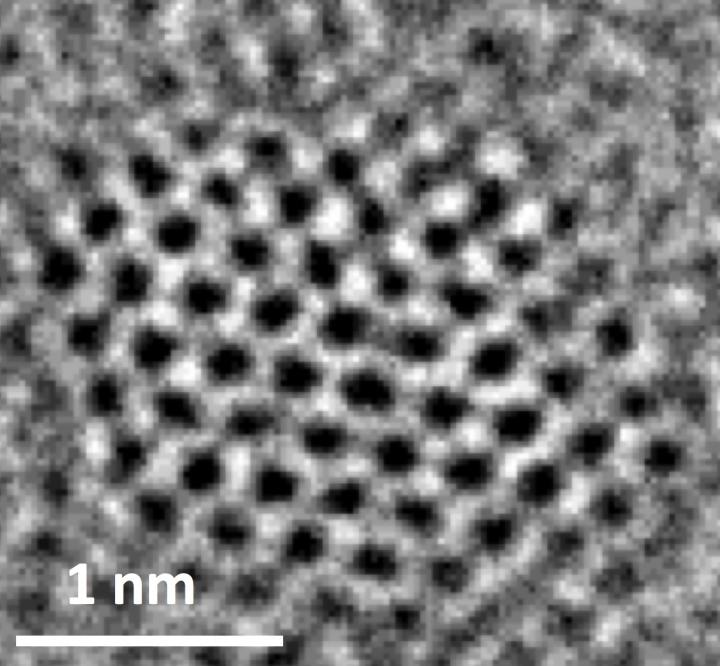Dec 19 2016
 A single nitrogen-doped graphene quantum dot with zig-zag edges. Credit: Ajayan Group/Rice University
A single nitrogen-doped graphene quantum dot with zig-zag edges. Credit: Ajayan Group/Rice University
Rice University scientists suggest that graphene quantum dots may provide a simple method for recycling waste carbon dioxide into valuable fuel instead of releasing it into the atmosphere or burying it underground.
A research team headed by Pulickel Ajayan, materials scientist at Rice, established the fact that nitrogen-doped graphene quantum dots (NGQDs) are an efficient electrocatalyst to produce complex hydrocarbons from carbon dioxide. Ajayan’s lab used electrocatalysis and demonstrated the conversion of the greenhouse gas into small batches of ethanol and ethylene.
The recent issue of Nature Communications features a detailed report of the research.
The researchers, even though they do not completely understand the mechanism, discovered that NGQDs worked almost as efficiently as copper, which is currently being tested as a catalyst in order to decrease carbon dioxide into chemicals and liquid fuels. The team reported that NGQDs keep their catalytic activity for a prolonged time period.
It is surprising because people have tried all different kinds of catalysts. And there are only a few real choices such as copper. I think what we found is fundamentally interesting, because it provides an efficient pathway to screen new types of catalysts to convert carbon dioxide to higher-value products.
Pulickel Ajayan, Materials Scientist, Rice University
Those problems are not a secret. Earlier this year, atmospheric carbon dioxide rose above 400 parts per million. This is the highest it has been in at least 800,000 years, based on the measurement through ice-core analysis.
“If we can convert a sizable fraction of the carbon dioxide that is emitted, we could curb the rising levels of atmospheric carbon dioxide levels, which have been linked to climate change,” said co-author Paul Kenis of the University of Illinois.
In lab tests, NGQDs proved to be capable of reducing carbon dioxide by up to 90% and transform 45% into either alcohol or ethylene, comparable to copper electrocatalysts.
Graphene quantum dots are known as atom-thick sheets of carbon atoms that have been divided into particles that are almost a nanometer thick and only a few nanometers wide. Varying chemical reactions are brought about by adding nitrogen atoms to the dots when an electric current is applied and a feedstock such as carbon dioxide is introduced.
Carbon is typically not a catalyst. One of our questions is why this doping is so effective. When nitrogen is inserted into the hexagonal graphitic lattice, there are multiple positions it can take. Each of these positions, depending on where nitrogen sits, should have different catalytic activity. So it’s been a puzzle, and though people have written a lot of papers in the last five to 10 years on doped and defective carbon being catalytic, the puzzle is not really solved.
Pulickel Ajayan, Materials Scientist, Rice University
“Our findings suggest that the pyridinic nitrogen (a basic organic compound) sitting at the edge of graphene quantum dots leads the catalytic conversion of carbon dioxide to hydrocarbons,” said Rice postdoctoral researcher Jingjie Wu, co-lead author of the paper. “The next task is further increasing nitrogen concentration to help increase the yield of hydrocarbons.”
Ajayan highlighted even though electrocatalysis seems to be effective at lab scales for now, industry depends on scalable thermal catalysis to develop chemicals and fuels. “For that reason, companies probably won’t use it any time soon for large-scale production. But electrocatalysis can be easily done in the lab, and we showed it will be useful in the development of new catalysts.”
Co-lead authors of the paper are Sichao Ma of the University of Illinois at Urbana-Champaign and Kyushu University, Fukuoka, Japan, and Jing Sun of the Shanghai Institute of Microsystem and Information Technology, Chinese Academy of Sciences.
Co-authors are Jake Gold, Lingyang Zhu, Aaron Yu and Raymond Luo of the University of Illinois at Urbana-Champaign; Chandra Sekhar Tiwary of Rice; Byoungsu Kim of the University of Illinois at Urbana-Champaign and Kyushu University; Nitin Chopra and Ihab Odeh of SABIC Americas, Inc., Sugar Land, Texas; Robert Vajtai, a senior faculty fellow in materials science and nanoengineering at Rice; Jun Lou, a professor of materials science and nanoengineering at Rice; and Guqiao Ding of the Chinese Academy of Sciences. Kenis is the William H. and Janet G. Lycan Professor and head of chemical and biomolecular engineering at the University of Illinois at Urbana-Champaign with an appointment at Kyushu University.
Ajayan is chair of Rice’s Department of Materials Science and NanoEngineering, the Benjamin M. and Mary Greenwood Anderson Professor in Engineering and a professor of chemistry.